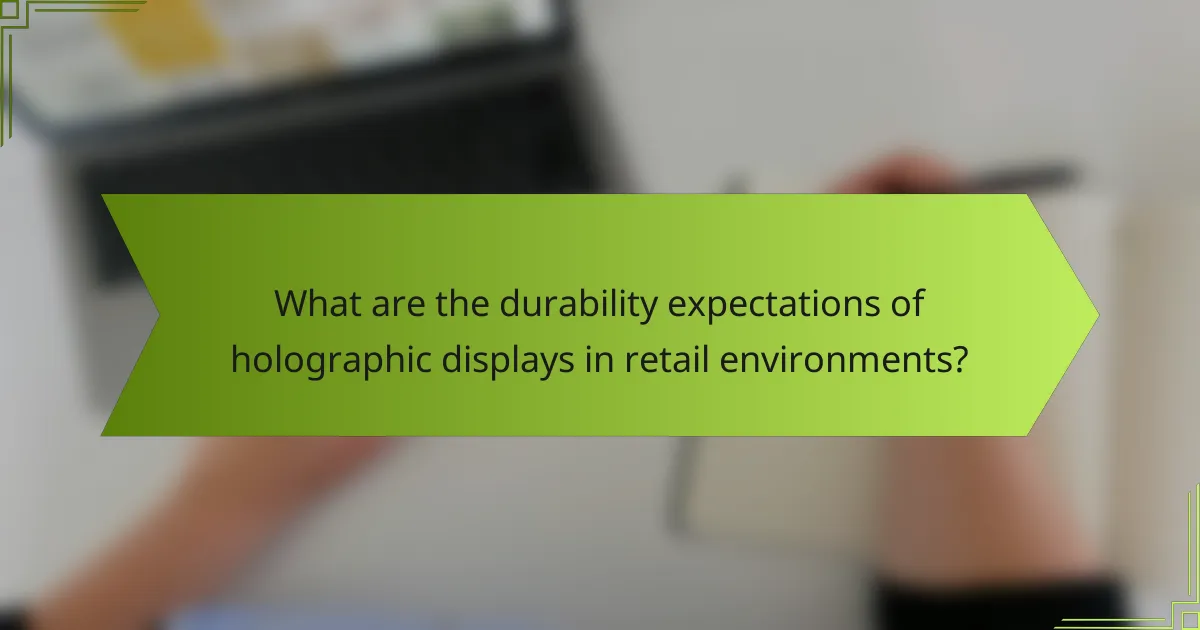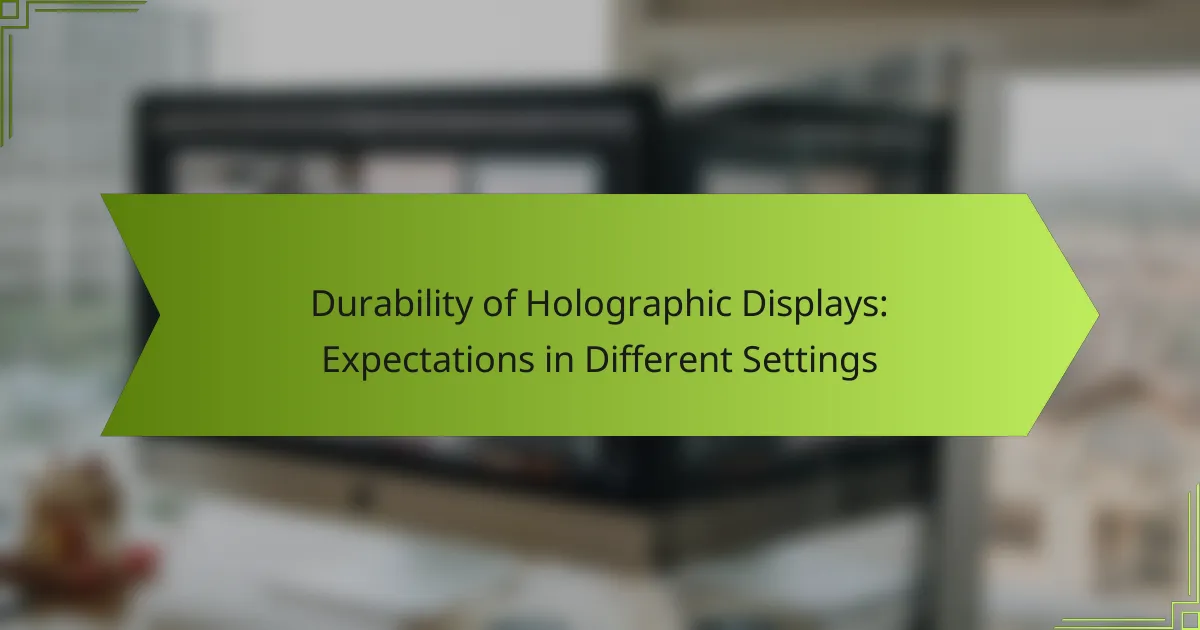The durability of holographic displays varies significantly across different settings, with specific expectations tailored to each environment. In retail, displays must endure frequent interactions and diverse conditions, while outdoor installations face challenges such as weather resistance and sunlight visibility. Factors like material quality, construction methods, and maintenance practices play crucial roles in determining the lifespan and performance of these innovative technologies.

What are the durability expectations of holographic displays in retail environments?
Holographic displays in retail environments are expected to be highly durable, capable of withstanding frequent use and various environmental factors. Retailers should consider both the physical robustness of the displays and their ability to maintain performance under different conditions.
High durability for frequent use
Holographic displays designed for retail must endure constant interaction from customers and staff. This means they should be built with tough materials that resist scratches and impacts, ensuring longevity even in high-traffic areas.
When selecting a holographic display, look for models that meet or exceed durability standards such as IP ratings, which indicate resistance to dust and water. Displays with a minimum IP65 rating are recommended for retail settings, as they can handle spills and dust accumulation effectively.
Resistance to environmental factors
Environmental factors like temperature fluctuations, humidity, and exposure to sunlight can affect the performance and lifespan of holographic displays. Retail environments often experience varying conditions, so displays should be engineered to operate effectively within a wide temperature range, typically from -10°C to 50°C.
Additionally, consider displays with anti-glare and UV-resistant coatings to minimize damage from sunlight and maintain visibility. Regular maintenance, such as cleaning and checking for wear, can further enhance the durability of these displays in retail settings.

How do holographic displays perform in outdoor settings?
Holographic displays in outdoor settings face unique challenges that can affect their performance, primarily due to environmental factors. Key considerations include their weather resistance and visibility under bright sunlight.
Enhanced weather resistance
Holographic displays designed for outdoor use often incorporate materials that provide enhanced weather resistance. This includes protective coatings that guard against moisture, dust, and UV radiation, ensuring longevity and reliability in various climates.
For optimal performance, look for displays with an IP rating of at least IP65, which indicates protection against dust and low-pressure water jets. This level of durability is crucial for maintaining functionality in rain or extreme temperatures.
Brightness and visibility challenges
One of the main challenges for holographic displays outdoors is achieving adequate brightness and visibility in direct sunlight. Many standard displays may struggle to be seen clearly in bright conditions, leading to user frustration.
To combat this, manufacturers often utilize high-brightness LED technology, which can exceed 1,000 nits, making the display more legible in bright environments. It’s advisable to choose displays specifically rated for outdoor use to ensure they meet visibility requirements.

What factors influence the lifespan of holographic displays?
The lifespan of holographic displays is primarily influenced by material quality, construction methods, usage frequency, and maintenance practices. Understanding these factors can help users maximize the longevity and performance of their displays.
Material quality and construction
The materials used in holographic displays significantly affect their durability. High-quality components, such as advanced polymers and durable glass, can withstand environmental stressors better than cheaper alternatives. For instance, displays made with tempered glass are less prone to scratches and damage compared to those with standard glass.
Construction techniques also play a crucial role. Displays that are well-assembled with precision engineering tend to have fewer defects and longer lifespans. Look for products that adhere to industry standards for quality assurance, as this can indicate a more reliable construction process.
Usage frequency and maintenance
The frequency of use directly impacts the wear and tear on holographic displays. Displays used in high-traffic environments, such as retail settings, may experience more damage than those in controlled settings like offices. Regularly assessing the condition of the display can help identify issues before they lead to significant problems.
Proper maintenance is essential for extending the lifespan of holographic displays. This includes routine cleaning with appropriate materials and avoiding exposure to extreme temperatures or humidity. Implementing a maintenance schedule can help ensure that displays remain in optimal condition, reducing the likelihood of costly repairs or replacements.

What are the common durability issues faced by holographic displays?
Holographic displays often encounter durability issues that can affect their performance and longevity. Common problems include screen scratches and damage, as well as color fading over time, which can diminish the visual quality and user experience.
Screen scratches and damage
Screen scratches and physical damage are prevalent issues for holographic displays, particularly in environments where they are frequently handled or exposed to abrasive materials. These displays often utilize sensitive surfaces that can easily be marred by contact with sharp objects or rough surfaces.
To mitigate the risk of scratches, consider using protective films or cases designed specifically for holographic displays. Regularly cleaning the screen with appropriate materials can also help maintain its integrity and visual clarity.
Color fading over time
Color fading is another durability concern for holographic displays, especially when they are exposed to prolonged sunlight or harsh lighting conditions. Over time, the vibrancy of the colors can diminish, leading to a less engaging visual experience.
To reduce color fading, position displays away from direct sunlight and use UV-filtering screens when possible. Regular maintenance and calibration can also help preserve color accuracy and extend the lifespan of the display’s visual quality.

How do different brands compare in durability?
Durability varies significantly among holographic display brands, influenced by design, materials, and intended use. Understanding these differences can help users select the right device for their specific environment and application.
Microsoft HoloLens durability features
The Microsoft HoloLens is designed for robust use in professional settings, featuring a durable casing that meets military standards for toughness. Its construction includes a hardened glass lens, which is resistant to scratches and impacts, making it suitable for industrial applications.
Additionally, the HoloLens has an adjustable headband and a lightweight design, allowing for extended wear without discomfort. Users should consider regular maintenance to ensure optimal performance, particularly in environments with high dust or moisture levels.
Vive Pro specifications and performance
The Vive Pro is known for its high-quality visuals and immersive experience, but its durability is somewhat less robust compared to the HoloLens. It features a plastic casing that is more susceptible to wear and tear, particularly in high-impact scenarios.
While the Vive Pro offers excellent performance in controlled environments, users should take care to protect it from drops and extreme conditions. Investing in protective accessories, such as carrying cases or screen protectors, can enhance its longevity in various settings.

What maintenance practices enhance the durability of holographic displays?
To enhance the durability of holographic displays, regular maintenance practices are essential. These practices include implementing cleaning protocols and utilizing protective casings to prevent damage from environmental factors.
Regular cleaning protocols
Regular cleaning is crucial for maintaining the clarity and functionality of holographic displays. Use a microfiber cloth and a gentle cleaning solution specifically designed for electronics to avoid scratches and residue buildup.
Establish a cleaning schedule, ideally every few weeks, depending on the environment. For high-traffic areas, consider cleaning more frequently to mitigate dust and smudges that can impair visibility.
Protective casing options
Protective casings can significantly extend the lifespan of holographic displays by shielding them from physical impacts and environmental hazards. Look for casings that are made from durable materials like polycarbonate or tempered glass, which offer good resistance to scratches and shocks.
When selecting a casing, ensure it is compatible with your specific display model and allows for adequate ventilation. This prevents overheating while still providing protection. Regularly inspect the casing for any signs of wear or damage and replace it as needed to maintain optimal protection.

What emerging technologies improve holographic display durability?
Emerging technologies are enhancing the durability of holographic displays through advanced materials and protective coatings. These innovations aim to increase resistance to physical damage, environmental factors, and wear over time.
Advanced materials in development
Researchers are exploring various advanced materials to improve the structural integrity of holographic displays. For instance, materials like graphene and carbon nanotubes offer exceptional strength and flexibility, making them ideal for durable screens.
Additionally, polymers infused with nanomaterials are being developed to provide lightweight yet robust options. These materials can withstand impacts and scratches, significantly extending the lifespan of holographic displays in various settings.
Smart coatings for protection
Smart coatings are designed to enhance the durability of holographic displays by providing a protective layer against environmental hazards. These coatings can be hydrophobic, preventing water damage, or oleophobic, resisting oil and fingerprints.
Some coatings also incorporate self-healing properties, allowing minor scratches to repair themselves over time. This technology not only maintains the display’s clarity but also reduces maintenance costs, making it a practical choice for commercial applications.

What are the future trends in holographic display durability?
Future trends in holographic display durability focus on enhancing resilience against environmental factors and improving longevity through advanced materials. Innovations in protective coatings and structural designs are expected to significantly increase the lifespan and reliability of these displays across various settings.
Advancements in Materials
New materials are being developed to enhance the durability of holographic displays. For instance, the use of flexible polymers and advanced glass composites can provide better resistance to scratches and impacts. These materials not only improve durability but also maintain high optical quality, essential for effective holographic visuals.
Environmental Resistance
Holographic displays are increasingly designed to withstand harsh environmental conditions. This includes resistance to humidity, temperature fluctuations, and UV exposure. Displays intended for outdoor use, for example, may incorporate weather-resistant features to ensure functionality and longevity in varying climates.
Regulatory Standards and Testing
As holographic displays become more prevalent, adherence to industry standards for durability is crucial. Manufacturers are likely to follow guidelines similar to those for traditional display technologies, such as IEC standards, which outline testing methods for impact resistance and environmental durability. Compliance with these standards helps ensure that products meet consumer expectations for performance and reliability.
Market Expectations
Consumers are increasingly demanding durable holographic displays that can perform reliably in diverse settings, from retail environments to industrial applications. As the technology matures, expectations for durability will rise, pushing manufacturers to innovate continuously. Companies that prioritize durability in their designs are likely to gain a competitive edge in the market.
